Nike, Ben & Jerry’s, Wendy’s, Airbnb, Make-A-Wish Foundation, Starbucks, Patagonia, IHOP. What do all of these companies have in common? They all have well strategized social media marketing plans.
No matter what industry your company falls into, your business can benefit from a comprehensive social media marketing plan.
The business world is constantly changing, and companies are faced with two options: adapt or die. Throughout recent years of technological development and the evolvement of society’s communication methods, social media strategies have become a must have for every business.
Having a social media plan is no longer a matter of gaining an edge over your competitors – it’s now essential to have just to try and keep up with them.
A Guide to Social Media Marketing
Why You Need a Social Media Strategy
Developing a social media marketing strategy will benefit your business in a whole bunch of different ways. When you implement a social strategy, you’re delivering your content and communicating with your audience at the core hub of their activity. Doing this can expand brand awareness to new, targeted users and drive traffic to your site.
By engaging in conversations with your audience, you can build an active community that will foster brand loyalty and create excitement around your products and services.
Social media use also allows you to gather research and information about your target audience and specific segments. Pay attention to the conversations that are taking place, and identify the pain points and empty niches that your company can address.
Believe it or not, social media strategies can even boost your SEO! You can generate valuable backlinks across multiple channels, which will increase your ranking potential in search engines.
The benefits of developing a social media strategy are undeniable when you look at the hard numbers of survey results:
Almost 90 percent of marketers say their social marketing efforts have increased exposure for their business, and 75 percent say they’ve increased traffic.
Additionally, more than 50 percent of marketers who have been implementing social media marketing tactics for two years have reported improved sales.
Quite frankly, if you haven’t yet built and implemented a social media marketing strategy, then you’re already way behind your competitors, and are actively ignoring proven growth opportunities that are just waiting to be tapped into.
What You Need for Developing a Social Media Plan With Your Marketing Team
Developing a social media plan can be a tricky and complicated business. In order to be successful, you need to compile a list of some essential elements that will be used for creating and managing your strategy.
Without these basics of social media marketing, your plan could easily experience a pitfall.
Buyer Personas
Buyer personas are an essential element for building a successful marketing strategy in general, let alone for your social media strategy.
Without these in place, you won’t know who to target or how to speak to them. Your social posts could end up all over the place, and present a very different language to those of your target audience.
Social Media Tools
Creating and monitoring social media content can be extremely time consuming and difficult to keep organized. Even keeping track of your social media calendar can be a handful when you’re trying to schedule posts.
Luckily, there are a bunch of tools available to help you with these tasks.
Buffer
Buffer is a well known tool within the realm of social media marketing management. It allows you to schedule posts across all the different social channels – Facebook, Instagram, Twitter, LinkedIn.
You can pick and choose which days you want posts to be automated, and you can even go back and analyze data on past posts to see which were the most successful.
Hootsuite
Hootsuite is another popular social media management tool that has both a free and paid option. The free option allows you to schedule posts in advance across different channels.
Its data analytics feature is particularly useful, as it allows you track content engagement to analyze the success of your overall campaign.
Sprout Social
Sprout Social’s structure is a little different to that of Buffer and Hootsuite. With Sprout Social, a manager can use the tool to assign tasks to team members.
While this tool includes similar posting and analytics capabilities to the previous two, it also has a social listening tool that allows you to track when and how your brand is being mentioned on social media channels.
Style Guide
Developing a style guide is something you should do on the backend before you launch your social strategy. A style guide includes elements like tone, color schemes, and theme of content.
Using a style guide helps your company maintain consistency throughout messaging, themes, and tones so you always appear in sync with your brand.
Without a style guide, your social profiles can easily become sloppy, unprofessional, and off-tune with your brand and company messaging.
Analytics Strategy
Developing a social media strategy is great, but once you’ve posted content to your channels, you’ll need to analyze its engagement and success rate.
Having an analytics strategy helps your team identify KPIs and better understand how to set the right goals and define success for each campaign.
If you don’t carefully track the analytics data of your social channels, you could be wasting valuable resources on ineffective campaigns.
Steps for Developing a Social Media Marketing Plan
There’s a number of steps you can follow to develop a social media marketing plan in an organized in an efficient way. Following the steps outlined below will help you to build a fully rounded out social media strategy for ultimate success.
1. Audit Your Current Social Media Presence
In order to develop a social media strategy, you first need to audit your current social presence – if you have one at all.
There are four major channels to monitor your presence across – Facebook, Instagram, Twitter, and LinkedIn. Do you have company pages set up on these channels?
2. Establish Goals and KPIs Associated With Those Goals
Without goals, how are you supposed to correctly direct your social strategy? Establish SMART goals for your social media plan – whether it’s boost website traffic, expand brand awareness, or generate leads, make sure you know what you’re trying to achieve with your efforts, and how to measure that potential success.
3. Conduct a Competitor Analysis
Conducting a competitor analysis will help you figure out how you can stand out amongst them. What are your competitors doing well on their social channels, and where are they missing the mark?
What can you take inspiration from, and what can you do better? Consider these questions when you take to the internet to stalk the competition.
4. Plan Out Content Distribution
Make sure you plan out content distribution for each platform based on your goals, your audit information from your current channels, and your competitor analysis. This is an essential step to keep your strategy organized and effective.
Throwing content all over the place with no rhyme or reason can get messy and likely won’t be an efficient method to achieve your goals.
It’s a good idea to follow the 4-1-1 rule for social media posting. This guideline suggests that for every four new content posts you publish, you should also share one post (whether it’s from a partnering company, industry related news, or user-generated), and publish one self-promoting post.
Engaging in this rule will help you build a diverse range of engaging content on your social channels that both promotes your business and encourages conversation amongst your audience.
5. Optimize Each Platform
Did you know that social media performance can impact your SEO? Make sure all your posts and channels are optimized for premium SEO. There are loads of different factors that can affect this, from design to textual information.
Let's walk through every element you need to consider using this page optimization checklist.
A Page Optimization Checklist:
Optimize Your Header and Profile Images
Ensure each of your header and profile images fit the specifications for each platform. Profile image specs include:
- Facebook: Profile Picture: 180x180 pixels, Header Photo: 820x312 pixels
- Twitter: Profile Picture: 400x400 pixels, Header Photo: 1,500x500 pixels
- Instagram: Profile Picture: 110x110 pixels
- LinkedIn: Company Logo: 300x300 pixels, Company Header Photo: 1,536x768 pixels
Provide Complete Company Summaries on All Channels
Are you adding the most important information about your company? Remember, your social media profile might be the initial touchpoint, so make sure you have enough information to get new visitors up to speed in no time.
Optimize for SEO Keywords
Remember, social media platforms are their own search engines. Use the right keywords in your profile descriptions and summaries so searchers who look for information relevant to your company can actually find you.
Pin Your Best Content or Limited-Time Promotions to the Top of Your Pages
This is not available for every platform. But Twitter, Facebook, and LinkedIn all allow users to pin content at the top of their feeds and timelines to drive engagement to certain posts.
So make the most of this with your best performing posts or to raise awareness about specific promotions.
Include Relevant CTAs in Profiles
For example, a contact us button on your Facebook company page gives followers a direct line to your organization.
Your CTAs will depend on your business and what exactly you want users to do when they visit your social media profile. Be clear about what action you want them to take.
6. Asses and Evolve
Make sure you continually run analytics on the success of your campaigns, and use that data to develop more effective strategies for the future. Analytics data can help inform your strategies like best times to post, top performing content types, and effective messaging.
Additionally, engaging in social listening can help you understand where and how your brand is being discussed across social channels, so you can better understand your audience and direct those conversations in a positive way.
The Best Social Media Marketing Plan Examples
MoonPie Wins With Humor
One of the best ways to engage your audience on social media is with the art of humor. Funny social accounts tend to drive an immense amount of traffic, and inspire tons of brand loyalty.
Amongst some of the most hilarious Twitter accounts is MoonPie, a company that creates tiny desserts made of graham crackers, marshmallow, and chocolate. Basically, it's a s'more without the campfire.
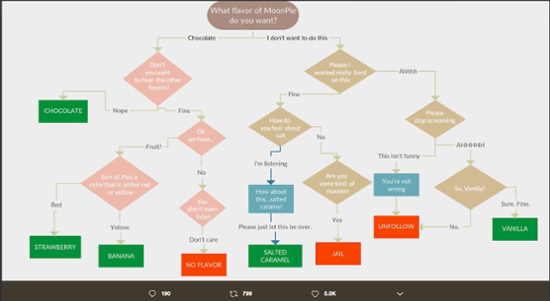
Check out this flow chart they made – "What flavor of MoonPie do you want?" You get a good chuckle from reading through it, and it's a fresh take on posting visual content.
Check out the engagement that this post has received – 190 comments, 799 retweets, and 5,000 likes! But if you're impressed by that, their regular tweets perform just as well.
MoonPie displays their brand personality and utilizes their name to create a lot of humor, often discussing moon-related subjects and declaring war on the sun.


In addition to utilizing their brand name, they also engage in topical humor based on the time of year and current events.
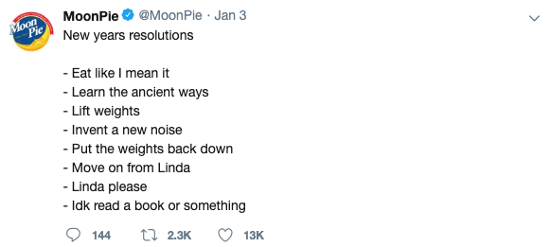
Honestly, how can you not laugh at this list? Pay attention to the amount of engagement these three tweets received – each received at least 12,000 likes, 2,000 retweets, and over 100 comments.
Making your audience laugh entertains them and ensures that they'll keep coming back for more.
Airbnb Shows Tourists the Best Spots
Ah, Airbnb. You've changed the travel industry forever. Airbnb has launched some impactful social media campaigns, including their We Are Here campaign using Facebook livestream videos. As video has become revolutionary in the world of marketing, Facebook live has slowly started to be used more and more.
Airbnb created the campaign to promote their new Airbnb experiences service and show their customers what there is to do in different cities across the world, from Paris to Miami to Seoul.
It focused on displaying a local's experience of cities. The campaign was an effective use of Facebook live, and inspired customers to go out, travel, and try new experiences.
In this video, people are trying out a Latin cooking class in Miami, taught by an Airbnb host. Not the immense amount of engagement this content received – 411 shares, 5,600 reactions, and over 1.9 million views.
Make-A-Wish Pulls Heartstrings
Utilizing emotion within your marketing campaigns is one of the most effective strategies out there, and the Make-A-Wish foundation knows how to pull at people's heartstrings.
Back in 2013, the Make-A-Wish foundation granted the wish of a young boy named Miles fighting leukemia – to become Batkid. They used social media to create enough fervor and buzz around the project to make it one of the biggest wishes every granted by the foundation.
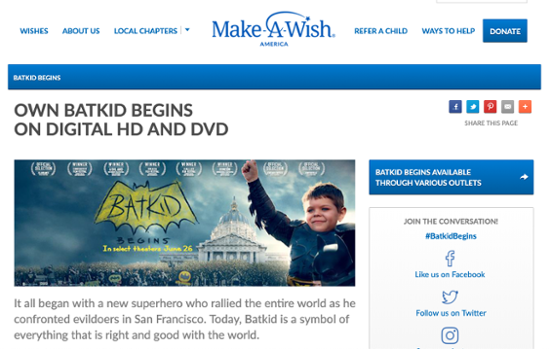
With the buzz created by their social media campaigns, the foundation managed to recruit Warner Bros onto the project, turning San Francisco into Gotham City for a day and filming a mini documentary titled Batkid Begins.
Starbucks Dazzles with Unicorns
For some reason, a unicorn obsession has permeated our culture in recent years. For whatever obscene reason this seems to be taking place, coffee mogul Starbucks found a way to capitalize on the craze.
In April 2017, Starbucks launched a unicorn Frappuccino. The catch? They only released it for one week.
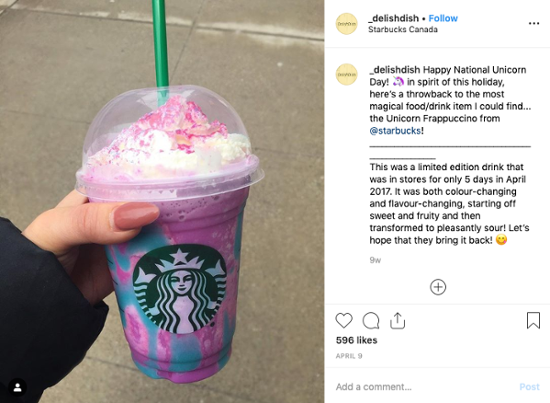
They created an Instagram hashtag with the launch (#unicornfrappuccino), and you better believe that Insta influencers and commoners alike went mad for it.
In the single week that the unicorn frap was destroying our coffee culture, the hashtag received almost 155,000 user generated posts.
But in all honesty, Starbucks did a number of things right in their efforts that made this campaign particularly effective.
They created a product that fed into the current trends of culture, they focused on a targeted audience (millennials), created urgency by only releasing the product for a week, and delivered their content on a hub where they know their audience engages – Instagram.
IHOP Unveils New Logo
In the summer of 2018, IHOP, the International House of Pancakes, decided to jokingly rebrand as IHOB – International House of Burgers. They launched the news on their Twitter account, and the Twittersphere had a frenzy.
The campaign was launched to promote the restaurant chain's new line of burgers. Nevertheless, customers took it very seriously, and were concerned that IHOP would no longer be making pancakes.
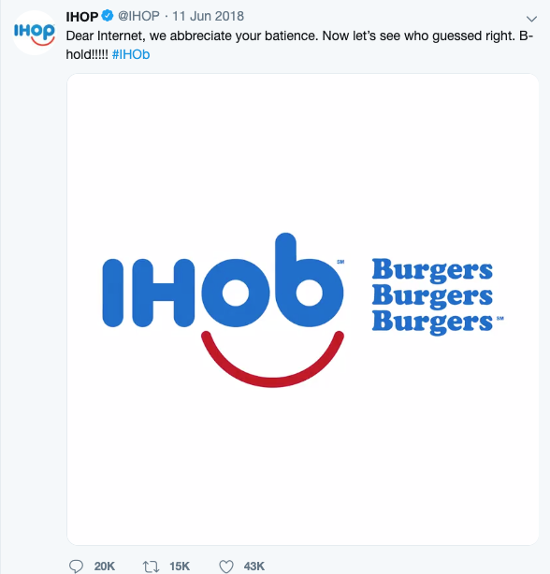
When IHOP announced the launch, they received a lot of commentary from customers stating "stick to what you know – pancakes." Today, IHOP has taken that commentary and run with it, continuing with the burger humor on their Twitter.
All the commotion over the logo tease boosted brand awareness – and burger sales – for the restaurant chain.

Get Social!
With the right social media marketing plan in place, your company will be able to drive significant results in your overall marketing efforts.
Remember, consider your target audience and which platforms they're most active on. This will allow you to optimize your campaigns to reach your potential customers in a more effective, impactful way.

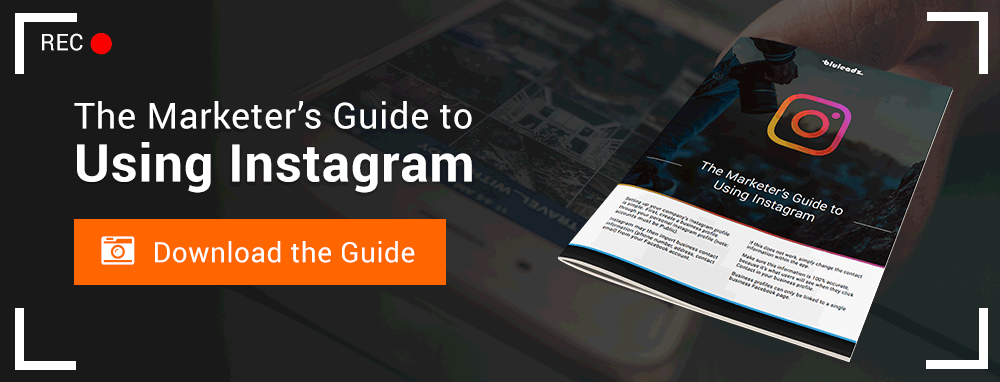
Claire Cortese
I am a content creator here at Bluleadz. In my free time, I enjoy hugging dogs, watching reruns of The Office, and getting sunburnt at the beach.